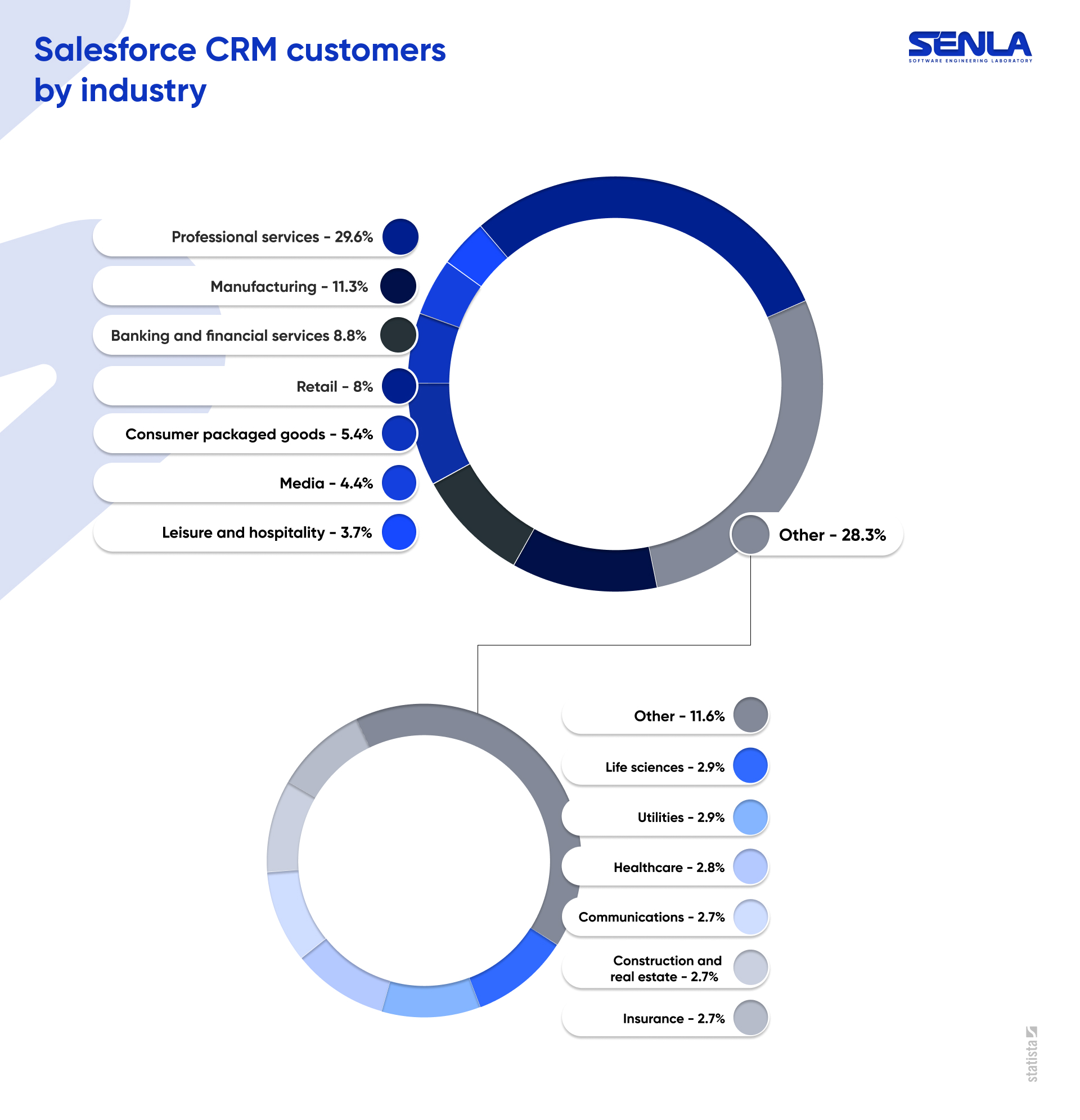Salesforce Customization: Overview
Every business is unique and has different workflows, processes, and needs. As per Salesforce, 72% of B2B customers are deeply interested in customized tools to achieve their sales goals. Salesforce CRM was designed to fit the characteristics of any business. This platform has features, components, and functionality for different business purposes. Its full potential can be unlocked by configuration and customization.
The article explains the difference between configuration and customization. The former refers to the situation when Salesforce improvement can be done in-house, while the latter means that a company needs the support of Salesforce customization services.
What Does Configuration Mean in Salesforce?
Configuration and customization allow using Salesforce CRM to create the best strategies for your business. Configuration is based on utilizing the platform’s built-in functionality and components and doesn't require programming skills.
Examples of Salesforce Configuration
A Salesforce admin can configure CRM with point-and-click tools to resolve the following issues:
- adding more objects or fields;
- adding tabs and apps;
- creating new profiles and permissions;
- working with validation rules;
- creating email templates;
- working with reports and workflows;
- setting up dashboards, page layouts, custom tabs.
If the built-in options are not enough, you can find additional software in the App Exchange store. For instance, you might download applications to integrate Salesforce with external data sources such as G-Suite or Slack.
What Is Customization in Salesforce?
Salesforce customization helps to implement thousands of useful features and gives ample opportunities when configuration doesn't work. However, in this case, the company needs a Salesforce developer to code.
Examples of Salesforce Customization
Customization provides efficient solutions to companies:
- creating Apex classes and triggers;
- integrating Salesforce with several external data sources;
- adding capabilities with JavaScript;
- changing the User Interface (UI) and page layout with API;
- using Visualforce to create email templates;
- automating record updates.
Companies of various industries use the Salesforce CRM product to solve problems at different levels. Statista has recently shown that almost 30% of customers come from the professional services industry. Other leading industries include manufacturing, banking, retail, and media.
Configuration and Customization are equally important to tailoring CRM for your business needs. The configuration provides many options for improving Salesforce without coding and experts usually recommend starting with it. Salesforce customization offers more options, but it requires programming in Apex.
How to Choose Between Customization or Configuration?
There are several common situations where Salesforce set up can really help.
The disadvantage of automation
Every business has repetitive tasks which are usually done manually. Automation helps increase employees’ productivity and optimize the work processes.
To configure some standard procedures you can use default Salesforce tools such as Process Builder, Approvals, Workflow, and Flow Builder. For example, Process Builder is a point-and-click tool that lets you send an email and custom notification, create and update records, and submit it for approval. Workflow helps automate standard internal processes to save time across your company.
To achieve more with automation you need Apex to create custom workflows. SENLA had such experience with the Client who lacked an engine for filtering needed data and automating routine processes. Our team developed a banking web application that could read stored data, find and show the best results in the form of tables, charts, and interactive graphics. As a result, the Client’s turnover increased by 30%.
Inconvenient UX/UI
Salesforce isn’t that simple to use, and one of the biggest hurdles to user adoption and retention is usability. If your team members experience difficulties while working with Salesforce, your company may waste time and money. Configuration and customization help to adapt the platform and make it more transparent and comprehensible for users.
Salesforce configuration is done through CSS framework Salesforce Lightning Design System (SLDS). With SLDS it’s easy to create a more intuitive interface, add new features and services, and unique interactive tools for data visualization.
Salesforce customization provides additional opportunities and can solve specific UI problems with Apex and Lightning Web Components (LWC).
Inefficient analytics
One of the CRM's goals is to lead to insights and provide information for your sales team to improve their strategy and close more deals. But if you see that Salesforce data doesn't work and you miss a lot of potential customers, it’s time to improve reports.
You can configure Salesforce with the drag-and-drop Report Builder. It helps create reports with the necessary criteria, fields, filters, groupings, and charts.
If you want to build custom dashboards or automate reporting tasks, you need Salesforce customization with Apex. Sometimes your reports need specific information that is hard to find. In this case the Salesforce Object Query Language (SOQL) can help a lot.
The lack of third-party integrations
You can use the data and functionality of other apps along with Salesforce. Integration of the disparate systems increases the productivity of your staff and improves operations, letting your team close more sales. In Salesforce you can integrate data sources using point-and-click tools or code.
The AppExchange market provides pre-built applications for Salesforce integration with a single data source. The apps easily connect to on-premises and cloud-based apps but are not suitable when you need to integrate multiple systems. To reduce the salesforce integration cost you need code-based customization with Apex which can integrate your CRM with several data sources. In this case, you can make the system work with your email, Google apps or HubSpot.
Create roles with different access levels to CRM
Providing data security is one of the critical business challenges. It’s important that every user has access to the relevant information. In this way, users can share the information without security disruption. Configuration Roles, Profiles, Permission sets help achieve these goals.
How to Prepare for Salesforce Customization?
All companies have different business needs and choose different ways to configure their Salesforce CRM. The following strategy helps make the best solutions for your business.
1. Collect and prioritize the information.
It’s a good option to get information from employees about their working experience with the system. Primarily attention should be paid to difficulties, helpful functions that need to be added, and also unsuitable features to your business needs. The next step is to prioritize this information. It helps you see which options can be improved primarily and choose between configuration and customization.
2. Choose the right type of sandbox.
Sandbox is a safe environment where you can create copies of CRM, test changes without compromising the data and applications and teach end-users.
There are 4 sandbox types:
- Developer Sandbox. It is an isolated environment where you can create copies of your product, develop and test it. It doesn’t include sandbox templates and copy metadata only.
- Developer Pro Sandbox. The main difference between this sandbox and the previous is that it can host larger datasets. It provides bigger opportunities for development, testing, and user training.
- Partial Copy Sandbox. This sandbox type usually is used as an environment for acceptance testing, integration testing, and training. Here you can create a copy of all metadata and sample object data and have access to sandbox templates.
- Full Sandbox. Only this sandbox supports performance testing, load testing, and staging. Here you can copy all your metadata and data. To limit it and get only that you need for testing, apply a necessary sandbox template.
3. Decide who will perform the setup.
There are two variants to choose from and each has its pros and cons. Let’s take a closer look.
To hire Salesforce experts. Advantages of outsourcing Salesforce development:
- Price-wise expertise. Third-party developers provide high expertise and competence in specific issues. It allows them to find the best and fastest solutions for your business.
- Saving time and money. You needn't start the hiring process and prepare equipment and a workplace for your team.
Probably the main cons of working with a remote Salesforce development team are security risks because with access to CRM developers get access to your business data. The signing of a non-disclosure agreement helps to avoid this risk.
To build an internal Salesforce developers team. This decision has 2 main benefits:
- In-house experts usually better understand the requirements of your business.
- Workflows are more transparent. The main cons - it takes a lot of time to form an expert Salesforce team and doesn’t work when you need fast solutions. Also, the cost of growing your own skilled team is usually higher.
Get the Most Out of Your CRM
These are the most common situation where configuration and customization can help.
- Change Salesforce interface according to users' needs.
- Migrate Aura Components to Lightning Web Components and take all performance benefits of LWC.
- Integrate Salesforce with other tools and applications.
- Improve analytics and reports quality.
A basic Salesforce solution might not be a perfect fit as it might not suit your way of doing business and specific requirements. Although the standard functionality of Salesforce may help your business increase sales and marketing revenues, you can make this CRM even more valuable. Thanks to Salesforce configuration and customization, businesses can get the most out of CRM and increase the ROI of Salesforce implementation.






